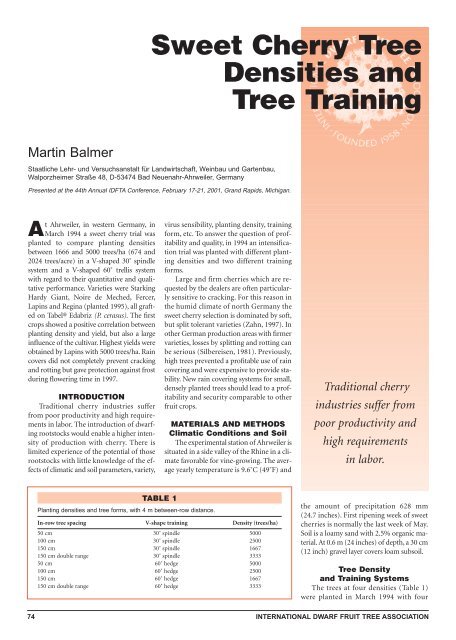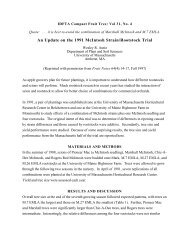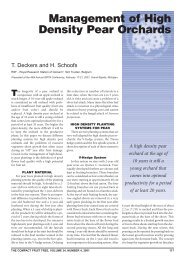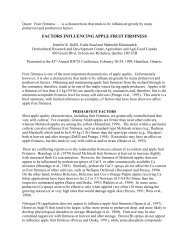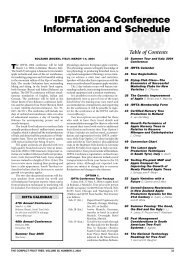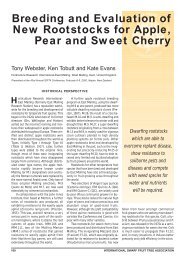You also want an ePaper? Increase the reach of your titles
YUMPU automatically turns print PDFs into web optimized ePapers that Google loves.
Sweet Cherry TreeDensities andTree TrainingMartin BalmerStaatliche Lehr- und Versuchsanstalt für Landwirtschaft, Weinbau und Gartenbau,Walporzheimer Straße 48, D-53474 Bad Neuenahr-Ahrweiler, GermanyPresented at the 44th Annual <strong>IDFTA</strong> Conference, February 17-21, <strong>2001</strong>, Grand Rapids, Michigan.At Ahrweiler, in western Germany, inMarch 1994 a sweet cherry trial wasplanted to compare planting densitiesbetween 1666 and 5000 trees/ha (674 and2024 trees/acre) in a V-shaped 30˚ spindlesystem and a V-shaped 60˚ trellis systemwith regard to their quantitative and qualitativeperformance. Varieties were StarkingHardy Giant, Noire de Meched, Fercer,Lapins and Regina (planted 1995), all graftedon Tabel® Edabriz (P. cerasus). The firstcrops showed a positive correlation betweenplanting density and yield, but also a largeinfluence of the cultivar. Highest yields wereobtained by Lapins with 5000 trees/ha. Raincovers did not completely prevent crackingand rotting but gave protection against frostduring flowering time in 1997.INTRODUCTIONTraditional cherry industries sufferfrom poor productivity and high requirementsin labor. The introduction of dwarfingrootstocks would enable a higher intensityof production with cherry. There islimited experience of the potential of thoserootstocks with little knowledge of the effectsof climatic and soil parameters, variety,virus sensibility, planting density, trainingform, etc. To answer the question of profitabilityand quality, in 1994 an intensificationtrial was planted with different plantingdensities and two different trainingforms.Large and firm cherries which are requestedby the dealers are often particularlysensitive to cracking. For this reason inthe humid climate of north Germany thesweet cherry selection is dominated by soft,but split tolerant varieties (Zahn, 1997). Inother German production areas with firmervarieties, losses by splitting and rotting canbe serious (Silbereisen, 1981). Previously,high trees prevented a profitable use of raincovering and were expensive to provide stability.New rain covering systems for small,densely planted trees should lead to a profitabilityand security comparable to otherfruit crops.MATERIALS AND METHODSClimatic Conditions and SoilThe experimental station of Ahrweiler issituated in a side valley of the Rhine in a climatefavorable for vine-growing. The averageyearly temperature is 9.6˚C (49˚F) andTraditional cherryindustries suffer frompoor productivity andhigh requirementsin labor.TABLE 1Planting densities and tree forms, with 4 m between-row distance.In-row tree spacing V-shape training Density (trees/ha)50 cm 30˚ spindle 5000100 cm 30˚ spindle 2500150 cm 30˚ spindle 1667150 cm double range 30˚ spindle 333350 cm 60˚ hedge 5000100 cm 60˚ hedge 2500150 cm 60˚ hedge 1667150 cm double range 60˚ hedge 3333the amount of precipitation 628 mm(24.7 inches). First ripening week of sweetcherries is normally the last week of May.Soil is a loamy sand with 2.5% organic material.At 0.6 m (24 inches) of depth, a 30 cm(12 inch) gravel layer covers loam subsoil.Tree Densityand Training SystemsThe trees at four densities (Table 1)were planted in March 1994 with four74 INTERNATIONAL DWARF FRUIT TREE ASSOCIATION
varieties differing in habits, vigor and productivity.The cultivars were Noire deMeched, Fercer, Lapins and StarkingHardy Giant. One year later, Regina wasadded. All varieties are grafted on Tabel®Edabriz (Prunus cerasus, Asiatic type). Tohave equal start conditions for the twotraining systems, all trees were cut down to70 cm (28 inches) above the soil level. Onlyin a density of 5000 trees/ha (2024 trees/acre) for the spindle system heading wasavoided. For having a weaker growth of thebasal side limbs, all side buds above 90 cm(35 inches) were removed by sparing theterminal bud.The two training systems are the slightlyoblique 30˚ V spindle, attached to abamboo pole in a 30˚ V construction andthe 60˚ V-shaped trellis hedge. The latterdiffers from the Australian Tatura trellis(Y-shaped) by individual trees being inclinedalternately from one side to theother (van den Ende and Chalmers, 1975).Depending on the planting distance thenumber of trees per treatment unit variedbetween 7 and 21.The whole trial was covered by two differentrain shelter constructions. Since1997, plastic was spread out not only duringripening time for about 5 to 6 weeksbut also at bloom as a frost shelter.MeasurementsFor the performance of the plantingsystem standard measurements are carriedout as follows: Yearly crop per tree separatedinto intact, cracked and rotten fruits.Rotten fruits with cracks are placed in theclass of cracked fruits. Productivity is expressedin kg per stem circumference, fruitsize by average weight of one fruit from asample of 50 fruits (Schmidt et al., 1985).Flesh firmness is measured by the FrenchDurofel instrument (a dynamometer witha bolt of 0.25 cm 2 ) (Planton, 1992).The whole plot is fertigated and soilmoisture controlled by watermark tubes.RESULTSAfter planting in March 1994, the firstcrop was picked in 1996. Due to the preliminarycharacter of the study, only yielddata, losses by cracking and rotting, firmnessand fruit weight are shown.YieldThe mean yield values of four varietiesshow increasing crop correlated with increasingplanting density for both 1996and 1997 (Table 2). The V 60˚ hedge had alower average yield than the V 30˚ spindle.In 1998 + 1999 it was the opposite, but in2000 the spindle had advantages (Table 3).The yield development is very characteristicfor each training system: While the 30˚spindle is increasing continuously, the 60˚trellis hedge had decreasing yields in 2000(Fig. 1 and Fig. 2). There were also differencesdepending on the four varieties(Table 4): Fercer had its first yield only int/ha2520151050▲●■◆■▲●◆FIGURE 1●▲■◆the fourth growing season and Lapins wasthe most productive variety. The doublerange (DR) V 60˚ had a decidedly low yieldin 1997 because this range was not coveredat bloom.Yields of 30˚ spindle plantings at four tree densities from 1996 to 2000; mean values of 4●▲■◆▲■1996 1997 1998 1999 2000●▲◆■●▲◆■●▲■◆FIGURE 2▲■◆◆■▲●◆◆▲■●V 30˚,1666treesV 30˚,2500treesV 30˚,DR3333treesV 30˚,5000treesYields of 60˚ hedge plantings with four tree densities from 1996 to 2000; mean values of 4t/ha25201510501996 1997 1998 1999 2000●●◆▲■●V 60˚,1666treesV 60˚,2500treesV 60˚,DR3333treesV 60˚,5000treesTHE COMPACT FRUIT TREE, VOLUME 34, NUMBER 3, <strong>2001</strong> 75
Losses By Cracking and RotIn 1996, cracked and rotted cherrieswere not separated. There was a higher losswith increasing number of trees/ha. LapinsV 30˚ spindle had a maximum with a lossof 79%. The examination of the 1997 cropshowed that most of the cracked and/or rottedcherries could be quantified as cracked. Itcould be proven that the influence of the yearand the variety has a significant effect oncracking and that covering cannot prevent itabsolutely.TABLE 2Mean yield values of 4 varieties in 1996-1997 (years 3 and 4) for two training systems each at four tree densities.Yield Yield rotten + cracked rotten + cracked FirmnessAngle (trees/ha) (t/ha) 1996 (t/ha) 1997 (t/ha) 1996 (t/ha) 1997 1997V30˚, 1666 3.22 7.85 0.91 0.71 61.0V60˚, 1666 0.70 2.58 0.18 0.28 60.0V30˚, 2500 5.13 9.12 1.32 1.33 62.2V60˚, 2500 2.38 6.50 1.23 0.75 62.8V30˚ DR Z 3333 4.60 11.16 1.33 1.38 62.0V60˚ DR 3333 0.54 0.95 0.27 0.24 63.5V30˚, 5000 5.35 8.98 1.74 1.22 64.2V60˚, 5000 3.21 9.25 1.13 0.88 64.0ZDR is double range.TABLE 3Yield of V 30˚ spindle and V 60˚ trellis, each at four tree densities, for 1998 to 2000 (years 5, 6 and 7); values are means of four varieties.Yield Yield Yield % rotten Soluble FirmnessAngle (trees/ha) (t/ha) 1998 (t/ha) 1999 (t/ha) 2000 + cracked 2000 solids 2000 2000V30˚, 1666 8.62 12.9 16.3 4.4 14.4 58.0V60˚, 1666 14.22 16.7 14.6 1.8 14.9 58.0V30˚, 2500 10.61 16.6 20.2 3.5 14.2 58.0V60˚, 2500 17.67 19.3 12.6 2.4 15.2 57.5V30˚ DR Z 3333 9.35 15.0 18.1 3.7 14.6 58.3V60˚ DR 3333 17.69 18.0 13.9 2.7 15.3 58.0V30˚, 5000 12.28 19.1 19.0 5.0 14.1 57.8V60˚, 5000 18.58 22.2 18.5 2.9 15.1 58.0ZDR is double range.TABLE 4Total yield (t/ha) 1996 + 1997 for V 30˚ spindle and V 60˚ trellis, each at four tree densities for four varieties.Noire de Meched Fercer Lapins S. H. GiantAngle (trees/ha) 1996 1997 1996 1997 1996 1997 1996 1997V 30˚, 1666 4.78 10.38 0.00 6.76 3.71 5.12 4.33 9.22V 30˚, 2500 4.30 12.80 0.00 3.61 9.68 11.15 6.45 8.92V 30˚, 5000 4.35 12.50 0.00 3.19 11.12 15.07 5.60 5.04V 30˚ DR Z 3333 2.50 7.72 0.00 7.29 9.62 17.13 5.88 12.51V 60˚, 1666 0.59 4.40 0.00 0.20 0.48 1.39 1.74 4.33V 60˚, 2500 1.91 7.42 0.00 0.62 5.35 11.00 2.23 6.98V 60˚, 5000 3.74 13.96 0.00 3.14 4.98 10.97 3.83 8.99V 60˚ DR 3333 0.23 2.45 0.00 0.46 0.96 0.13 0.90 0.77ZDR is double range.TABLE 5Average fruit weight (g) in 2000 for two training systems, each at four tree densities with four varieties.Training system and tree density (trees/ha)Variety V 30˚, 1666 V 60˚, 1666 V 30˚, 2500 V 60˚, 2500 V 30˚, DR3333 V 60˚, DR3333 V 30˚, 5000 V 60˚, 5000Noire de Meched 9.4 8.9 9.2 9.8 11.5 10.7 9.4 9.4Fercer 11.0 9.9 10.5 9.9 10.9 8.9 10.8 10.8Lapins 10.6 9.9 9.0 11.0 8.7 9.2 9.7 9.9S.H. Giant 8.5 8.9 9.4 10.0 8.5 8.8 8.2 9.376 INTERNATIONAL DWARF FRUIT TREE ASSOCIATION
Fruit Weight and FirmnessThere was no general tendency in fruitweight. High density plantings with5000 trees/ha seemed to have the firmestfruits which is most apparent for Noire deMeched and Lapins (Table 2 and Table 6).Fruit weight seems to decrease at a thresholdwhich is typical for variety and yieldlevel. In 2000 at the lowest planting density(1666 trees/ha) V 60˚ trellis had on averagesmaller fruits than V 30˚ spindle for allvarieties.DiscussionTraditional mazzard orchards normallyhave their maximum potential of productivityfrom the 8th year. Average yield issaid to oscillate at about 10 to 12 t/ha inGermany (Ackermann et al., 1995). Firstresults prove that this level can be achievedin the 4th year with a dwarfing rootstockand a higher planting density. For these intensiveorchards poor croppers such asFercer give comparatively bad performance.At least for the first years of an orchard,a high density is favorable for goodyields. In the trial 5000 trees/ha were muchbetter than 1666 trees/ha.The very low yield in 1997 in the doublerange (DR) V 60˚ hedge is probablycaused by frost effect as this range was thenoncovered control during the criticalperiod.It is too early to discuss the potential ofproductivity of the two training systems.Losses by cracking and rotting were unexpectedlyimportant. Results of 1997 showedthat more cherries were split than rotted.Wounds in the fruit skin mostly causeMondia (sp.) infections subsequently (Minkand Jones, 1996) and we saw that mostcracked fruits were rotted at the pickingdate. Particularly susceptible was Lapins,showing a very dense and bunched fruit set.Consequently cultivar choice is also importantfor covered orchards and Monilia controlshould not be neglected. With removablecoverings (Selberg et al., 1995) it has tobe proven whether there is an influence onfruit quality. The hourly records of temperatureand relative humidity gave no cleardifferences.Best fruit firmness for the highestplanting density can be an effect of ripeningdate which is investigated on actualfruit samples.REFERENCESAckermann, I., R. Burmann, M. Görgens, B. Graf, D.Krümmel, M. Megies, D. Reymann, W. Riedel,M. Schilling, B. Schräder, R. von Soosten, L.Weiershäuser and K. Wettich. 1995.KTBL-Datensammlung Obstbau. 157 pp.TABLE 6Mink, G.I. and A.L. Jones. 1996. Cherry diseases:Their prevention and control. pp. 347-366. In:A.D. Webster and N.E. Looney. Cherries. CABInternational.Planton, G. 1992. Mesure de la fermeté au Durofel25 et 10. Infos Ctifl 80: 25-28.Schmidt, H., J.V. Christensen, R. Watkins and R.A.Smith. 1985: Cherry descriptor list: Int. BoardPlant Gen. Resources. 30 pp.Selberg, A., K. Skjervheim, M. Meland, J. Ulgenes andO. Hovland. 1995. Dekkesystem for sØtkirsebaer.Byggeretleling. [Covering systems forsweet cherries. Construction guide]. Faginfonr. 7. 1995. Infosenteret Forskningsparken iAs. 28 pp.Silbereisen, R. 1981. Die wirtschaftlich wichtigen Obstarten:Die Kirsche. In: F. Winter, H. Janssen,W. Kennel, H. Link and R. Silbereisen. Lucas’Anleitung zum Obstbau. Verlag Eugen Ulmer.526 pp.van den Ende, B. and D.J. Chalmers. 1975. The Taturatrellis: will it revolutionize fruit growing?Victoria Hort. Dig. 65: 12-14.Zahn, F.G. 1997. 30 Jahre Arbeit mit der Süßlkirsche- Erfahrungen und Ausblick. [Thirty years ofwork with sweet cherries - experiences andprospects]. 22. Bundessteinobstseminar 1996in Ahrweiler: 27-38.Average fruit firmness (Durofel 25) in 1997 for two training systems, each at four tree densitieswith four varieties.Training system Noire de Fercer Lapins S. H.(trees/ha) Meched GiantV 30˚, 1666 59.3 68.2 57.5 58.4V 30˚, 2500 57.4 71.0 57.9 62.9V 30˚, 5000 59.8 69.1 60.7 67.3V 30˚ DR 3333 60.9 69.3 57.6 60.1V 60˚, 1666 58.1 66.7 58.4 56.9V 60˚, 2500 59.4 72.2 58.4 61.7V 60˚, 5000 61.2 73.6 59.6 60.7V 60˚ DR 3333 55.8 73.5 58.5 66.0THE COMPACT FRUIT TREE, VOLUME 34, NUMBER 3, <strong>2001</strong> 77


